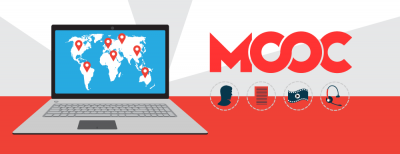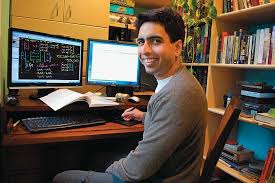MOOCs in K-12 Education

MOOCs have been hailed as a game changer in higher education. But Scott Garrigan is interested in their potential for K-12 education.
The jury is out as to whether MOOCs – (massive open online courses ) being offered by an increasing number of colleges and universities are an effective means of learning. But Scott Garrigan, Lehigh professor of practice of teaching, learning & technology in the College of Education, is already looking ahead to the day when MOOCs may be an integral part of the K-12 curriculum.
Garrigan is intrigued enough that he made a presentation on the subject at the International Society for Technology in Education conference in San Antonio over the summer.
“I’m interested in how effective it can be … its potential,” he says. “It’s definitely something drastically different than what we’ve seen before, and it’s coming from that most conservative institution, the American university.”
Online courses aren’t new, but MOOCs only became a phenomenon in the past two years. They differ from traditional online classes in that they feature informal video presentations of five to 15 minutes by top professors on various subjects, with frequent pauses for non-graded quizzes and instant feedback on the chunk of material just discussed. The course presenters can determine if students are missing certain questions far more than others, indicating that perhaps the material needs to be tweaked in some way to be clearer.
MOOCs have been hailed by some as a game changer in higher education—providing a universal, high-quality, low-cost education to anybody in the world with Internet access. Skeptics point out that they provide little or no interaction between students and professors, and are so new that there is scant research on their effectiveness.
Most MOOCs are free. Few are for credit, but that’s changing. The University of Maryland University College has begun offering credit for six MOOC courses. Georgia Institute of Technology will begin offering a MOOC-based online master’s degree in computer science in January for $6,600—a fraction of the $45,000 on-campus cost.
MOOC madness began when a free, non-credit course on artificial intelligence was offered by Stanford University in the fall of 2011. Some 160,000 students enrolled from around the world. Since then, three major providers of university-level MOOC courses have emerged. One of them, Udacity, was co-founded by a professor who taught that AI course. Another start-up, edX, began last year with $60 million in funding from the Massachusetts Institute of Technology and Harvard University. The third company, Coursera, has raised about $65 million in venture capital. Despite their rapid growth and sometimes breathless accolades, MOOCs have stumbled at times. San Jose State University opted in July to “pause” its partnership with MOOC provider Udacity to offer for-credit MOOCs because of low pass rates in three math courses.
Colorado State University-Global Campus offered credit for a computer science MOOC and students showed no interest. And a MOOC offered by Coursera and taught by a Georgia Tech professor was suspended after one week because of technology and design problems. The subject: “Fundamentals of Online Education: Planning and Application.”
Garrigan and others, however, see MOOCs in K-12 education as a different sort of online animal. He cites Khan Academy as why. Formed in 2008 by Salman Khan, a former hedge fund analyst with three degrees from MIT and an MBA from Harvard, the online platform provides free lessons in K-12 subjects, particularly math.
The academy provides interactive exercises and real-time data on student performance that lets them, their teachers and their parents gauge their progress. Khan pioneered the MOOC feature of short videos and immediate-feedback quizzes, Garrigan says. This method provides “an opportunity for retrieval of what was just learned, and places that content in long-term memory,” says Garrigan, who has taught and developed online courses and was a classroom teacher for 20 years.
“It implements a form of mastery learning that is otherwise difficult to manage with a group. It’s a model that seems to speak to the way we learn.”
Garrigan teaches the theory and implementation of MOOC technologies in his Instructional Technology classes to prepare Lehigh graduates to understand the education model and help design and build MOOC-like resources themselves for higher education and K-12.
 Khan received $3.5 million in grants from Google and the Bill and Melinda Gates Foundation in 2010. It now numbers 6 million users in 216 countries per month who can peruse more than 4,600 videos as of August, according to its website. It has pilot programs in a number of U.S. schools.
Khan received $3.5 million in grants from Google and the Bill and Melinda Gates Foundation in 2010. It now numbers 6 million users in 216 countries per month who can peruse more than 4,600 videos as of August, according to its website. It has pilot programs in a number of U.S. schools.
Certainly there is a need for improvement in K-12 learning. The latest annual report on ACT scores found that 31 percent of high school graduates weren’t ready for any college coursework requiring English, science, math or reading skills. Meanwhile, school districts in Philadelphia, Chicago and elsewhere are grappling with enormous budget crises.
Garrigan sees potential for MOOCs to not only improve K-12 learning but to save schools money. “Our existing K-12 system is very personnel-heavy,” he says. “By its very design it’s an expensive system. It deals in teaching groups of students where we know students’ needs are more individual.”
Robin Worley, a technology educator who is working on culture-based Hawaiian online history courses for students at the private, college-prep Kamehameha Schools in Hawaii, agrees. “My interest in education is in developing countries,” she says. “[But] even in the U.S. we’re lacking in qualified math and science teachers.”
MOOCs have the potential to enable high schools to offer electives that their budgets otherwise don’t permit, Garrigan says. They can “expand access to opportunity, expand access to higher-level courses … which typically would be under-enrolled and canceled at the high school level. There is essentially no incremental cost.” Mike Kaspar, a senior policy analyst at the National Education Association, is wary. “It’s going to continue to grow until people wake up to the real problems with it,” he says. Those problems, in Kaspar’s view, are that some students could lag behind if they don’t have a computer or Internet access, or their computer crashes. “For us at NEA, it’s about equity and fairness.” Kaspar also is concerned about who reviews MOOC content before making courses available.
Still, he concedes MOOCs may have some value in K-12 education. “They definitely have a role to play and they do it well in rural schools and with courses students wouldn’t otherwise have access to,” he says. “It serves a valuable purpose” if used to supplement, not supplant, classroom education.
That isn’t the intent, MOOC’s K-12 advocates say. A K-12 MOOC “is really just to fill in the holes where there aren’t necessarily experienced teachers in an area,” Worley says. “Absolutely, teachers are essential for K-12.” Worley is so sold on MOOCs that she has created a website to build a community of volunteers who she hopes will provide and vet MOOCS for K-12 global consumption.
MOOC higher education skeptics note that courses lack the interpersonal connection between students and professors that they have in a classroom setting. Students can email questions to the professor, but typically only those that are asked most often are answered online. In urban areas, MOOC students sometimes get together for study groups, but that’s less feasible in rural and suburban areas.
 That’s not an issue with K-12 education, supporters say. Khan Academy, for example, says that its courses free up teachers to interact directly with students. One method of doing so is in a “flipped classroom” where teachers assign a video for homework, then work on related problems in class the next day. Ideally, the academy says, students watch videos and work on exercises at their own pace.
That’s not an issue with K-12 education, supporters say. Khan Academy, for example, says that its courses free up teachers to interact directly with students. One method of doing so is in a “flipped classroom” where teachers assign a video for homework, then work on related problems in class the next day. Ideally, the academy says, students watch videos and work on exercises at their own pace.
The program allows the teacher to gauge students’ progress and areas where they need help. Critics also point out that the dropout rate in MOOCs is about 90 percent. Garrigan prefers to refer to completion rates. Put in context, the figures aren’t as bad as they seem, he says.
“Most students view taking a MOOC like browsing through a library, taking a book off the shelf and paging through it to see would I be interested in reading this book,” Garrigan says. “And most of the books they take off, they put back until they find one they are interested in. Then they take that and finish it.” Nor is Worley concerned about the low completion rate because K-12 MOOCS will ideally be used in face-to-face or blended instruction.
“There’s a demand from parents for online courses as low as first grade,” Garrigan says. “I see it as most applicable to the senior level of high school, and then going down to … some students at the sixth grade level who would be interested in taking some MOOC elements of courses and who would be successful. I don’t see MOOCs being threatening to K-12.”
MOOCs could enable high school students to graduate early or accumulate college credits before attending a university, Garrigan says. “I think there are a lot of things that would appeal to some high school students. This is not a one-size-fits-all. It’s more an opportunity to extend access. “I don’t see state departments of education rushing into this, nor should they. It’s totally unproven for K-12. It needs time to see where does it fit or not fit.”